“Quantum technologies exhibit remarkable potential to enhance or upend current warfighting capabilities. Fields such as sensing, computation, and communications are key mission areas in which quantum could make a significant impact. It is crucial that the Department of Defense (DoD), along with our allies and partners, maintain the leading edge in understanding advances in these technologies…. This is particularly pressing given adversarial investments being made towards quantum superiority, if not dominance.” — Dr. Craig Fields, Chairman, Defense Science Board, in the Final Report of the Defense Science Board (DSB) Task Force on Applications of Quantum Technologies — Executive Summary
[Editor’s Note: Given the significance of the DSB Chairman’s comments above, Mad Scientist Laboratory is pleased to publish today’s submission by guest blogger Robert McCreight, who delves into the potential technological convergences associated with quantum science and explores their associated implications for the Operational Environment. Read on to learn why the US must implement an era of ‘convergent technology surveillance’ to offset future risks of strategic surprise!]
If the future battlefield is a mixed threat scenario where conventional, traditional, hybrid, geospatial, and convergent technology permeate the multi-domain threat environment, how do we account for the sleeping giant dwelling amidst this landscape — the quantum threat? Is it enough to assume our own advancing technology, properly understood and harnessed, will offset any negative or unforeseen strategic disruption or damage which peer rivals and enemies may devise? The trick is initially a three-fold problem:
-
-
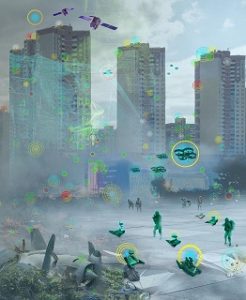 What does the full spectrum future battlespace of the next decade include?
What does the full spectrum future battlespace of the next decade include?
-
-
-
- Can our forces operate defensively and offensively within that space while maintaining a qualitative edge?
-
-
-
- Do we have accurate and reliable data and intelligence on the future battlespace capabilities of peer rivals and enemies?
-
Unless the answer is YES to all three of these questions, the argument can be fairly raised that we have discovered a capability gap adversely affecting our national security.
The fourth mega-question is:
How do we go about discerning the answers to the first three questions and engage in specifically engineered activities to nullify or close any discerned gaps?
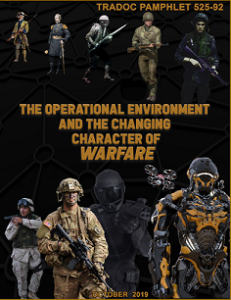 The future Operational Environment will be more complex and opaque than today with non-kinetic, as well as kinetic, platforms deployed to query, assess, conduct surveillance, and penetrate defenses covertly. But what is the nature of the quantum threat as it functions alongside convergent technologies and other hybrid strategies? First a definitional excursion is warranted. Convergent technology signals a threat dynamic elusively diverse in origins and purpose where genomics, nanoscale technologies, neurological technologies, cyber technologies, biochemical, and
The future Operational Environment will be more complex and opaque than today with non-kinetic, as well as kinetic, platforms deployed to query, assess, conduct surveillance, and penetrate defenses covertly. But what is the nature of the quantum threat as it functions alongside convergent technologies and other hybrid strategies? First a definitional excursion is warranted. Convergent technology signals a threat dynamic elusively diverse in origins and purpose where genomics, nanoscale technologies, neurological technologies, cyber technologies, biochemical, and 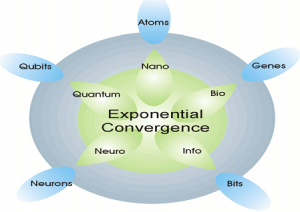 nanobiological systems are deliberately engineered to create a chimera-like array of mixed technical platforms designed to nullify, overcome, or defeat friendly defense systems. Hybrid strategies reflect an overall effort to achieve strategic objectives without using significant kinetic force. This is accomplished via indirect and non-kinetic amorphous influence, psychological, and information systems, along with disinformation campaigns and cyber attacks — in combination with actual lethal force in a phased maneuver approach over a long term campaign. In many ways, it deliberately blends classical warfare theory with cutting edge strategy. But what of the quantum issue and its indirect destructive and insidious effects?
nanobiological systems are deliberately engineered to create a chimera-like array of mixed technical platforms designed to nullify, overcome, or defeat friendly defense systems. Hybrid strategies reflect an overall effort to achieve strategic objectives without using significant kinetic force. This is accomplished via indirect and non-kinetic amorphous influence, psychological, and information systems, along with disinformation campaigns and cyber attacks — in combination with actual lethal force in a phased maneuver approach over a long term campaign. In many ways, it deliberately blends classical warfare theory with cutting edge strategy. But what of the quantum issue and its indirect destructive and insidious effects?
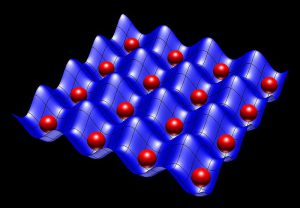
In the cyber and information space, quantum threats begin with decryption algorithms designed to overturn existing cyber security safeguards. Qubit-based systems reliant on latticed algoritms aim to disrupt and undermine cyber stability. For example, China has invested billions in enhanced quantum communications, while the US, somewhat behind in the same effort, sees an ongoing global race to exploit and operationalize quantum technologies for military purposes. Understanding the quantum battlefield is critical to grasping the changing nature of future warfare and technological conflict. Simply put, quantum dynamics are dedicated to global quantum supremacy where hard edged security is devised to nullify our own cyber systems while making a rival or foe’s system impervious to our attacks.
 Quantum science focuses on the behavior of matters and light as it influences electrons, protons, neutrons, and molecules at the atomic and subatomic levels. It is also aimed at understanding the interactive dynamics of subatomic particles, including quarks and gluons, operating within the effects of electromagnetic radiation. As such, it touches on, indirectly influences, or dramatically impacts most systems and technologies which we take for granted in 2020. Not every quantum interaction or influence is harmful or disruptive, but the geopolitical race to engineer and redirect quantum materials and issues has profound national security implications as it potentially connects with every tangible and virtual military system, sensor, and subcomponent.
Quantum science focuses on the behavior of matters and light as it influences electrons, protons, neutrons, and molecules at the atomic and subatomic levels. It is also aimed at understanding the interactive dynamics of subatomic particles, including quarks and gluons, operating within the effects of electromagnetic radiation. As such, it touches on, indirectly influences, or dramatically impacts most systems and technologies which we take for granted in 2020. Not every quantum interaction or influence is harmful or disruptive, but the geopolitical race to engineer and redirect quantum materials and issues has profound national security implications as it potentially connects with every tangible and virtual military system, sensor, and subcomponent.
 In the biosciences there is some controversy about quantum interference or influence in the cellular integrity of our bodies where telomeres or nanocellular dynamics are vulnerable to external influence. [Our chromosomes’ telomeres protect genomic DNA through various mechanisms, such as preventing ends of the linear chromosomal DNA from being recognized as a broken end. This prevents processes — such as DNA end-joining, DNA recombination, or DNA repair — that would or could lead to unstable chromosomes.] This only suggests a wide ranging field of defense inquiry involving quantum genetics.
In the biosciences there is some controversy about quantum interference or influence in the cellular integrity of our bodies where telomeres or nanocellular dynamics are vulnerable to external influence. [Our chromosomes’ telomeres protect genomic DNA through various mechanisms, such as preventing ends of the linear chromosomal DNA from being recognized as a broken end. This prevents processes — such as DNA end-joining, DNA recombination, or DNA repair — that would or could lead to unstable chromosomes.] This only suggests a wide ranging field of defense inquiry involving quantum genetics.

In defense communications, electronic warfare, and associated information operations, the quantum set of offensive and defensive applications undermining or reinforcing existing systems is not well known. For example, making quantum interactions self-sustaining for a longer dwell time means sustained solid state qubits artificially engineered for longevity could easily revolutionize quantum communication, computing, and sensing. Despite this fact, proximate background noise, vibrations, and randomized electromagnetic influences can disturb and dilute quantum operations. Engineered modifications may enable scientists to reduce or tune out some forms of temperature fluctuations, physical vibrations, and electromagnetic noise, all of which usually destroy quantum coherence. The net strategic impact of this insight is to extend and sustain quantum coherence, reinforce its viability, and thereby enhance its national defense value.
Various other aspects of quantum research in all dual-use scientific and technological activities in nano, neuro, genomic, cybernetic, hyperspectral,  and related defense technologies will be affected by this shift to maximize quantum coherence dynamically via engineering. What this implies for gauging and estimating friendly and enemy capacity to invest research resources in pushing the full measure of quantum issues as they potentially affect all weapons platforms and systems is nothing less than strategically spectacular.
and related defense technologies will be affected by this shift to maximize quantum coherence dynamically via engineering. What this implies for gauging and estimating friendly and enemy capacity to invest research resources in pushing the full measure of quantum issues as they potentially affect all weapons platforms and systems is nothing less than strategically spectacular.
Implications:
-
-
- How will our C4ISR systems be affected?
-
-
-
- How will strategic warning be affected?
-
-
-
- How will we gather enemy and rival state intelligence about quantum research beyond our shores?
-
-
-
- What avenues and approaches seem best in maintaining a leveraged strategic perspective on geopolitical quantum activities of all types designed to enhance the defense capabilities of other nations overseas?
-

These questions pose enormous technical and intelligence challenges for the immediate future — where tracking, understanding, and deciphering the significance of quantum research applied to national defense and military activities remains urgent. Multi-domain threats will manifest clearly in the realm of convergent technology, where multiple blends of cutting-edge science are deliberately crafted covertly to acquire a leveraged strategic advantage.
Devoted and dedicated efforts of a sustained and robust nature are needed by our nation to usher in an era of ‘convergent technology surveillance’ to offset future risks of strategic surprise and curtail developments where the US can no longer maintain a qualitative edge in future technologies. This will require vision, diligence, energy and imagination.
If you enjoyed this post, check out:
Proclaimed Mad Scientist Dr. Jamie Canton‘s presentation on Convergence of Future Technology [watch via a non-DoD network] from the Mad Scientist Robotics, Artificial Intelligence, & Autonomy Conference at Georgia Tech Research Institute, Atlanta, Georgia, 7-8 March 2017.
Emerging Technologies as Threats in Non-Kinetic Engagements, by proclaimed Mad Scientist Dr. James Giordano and CAPT (USN – Ret.) L. R. Bremseth
Quantum Surprise on the Battlefield? by proclaimed Mad Scientist Elsa Kania
Quanta of Competition and A Strategy for Everything: Quantum Artificial Intelligence, Quantum Multiverse, and Feedback Loop of Finite Information, by Victor R. Morris
>>> REMINDER: The Mad Scientist Initiative will facilitate our next webinar this Wednesday, 16 September 2020 (1100-1200 EDT):
 The Future of Unmanned Aerial Systems – featuring proclaimed Mad Scientist Mr. Sam Bendett, Advisor, CNA; Mr. Zak Kallenborn, Senior Consultant, ABS Group; and Mr. David Goldstein, Acting Branch Chief for the Precision Targeting & Integration Branch and a Counter- UAS Team Lead, Army Futures Command, Combat Capabilities Development Command, Armaments Center (AFC-CCDC-AC).
The Future of Unmanned Aerial Systems – featuring proclaimed Mad Scientist Mr. Sam Bendett, Advisor, CNA; Mr. Zak Kallenborn, Senior Consultant, ABS Group; and Mr. David Goldstein, Acting Branch Chief for the Precision Targeting & Integration Branch and a Counter- UAS Team Lead, Army Futures Command, Combat Capabilities Development Command, Armaments Center (AFC-CCDC-AC).
In order to participate in this virtual event, you must first register here [via a non-DoD network].
Robert McCreight is a retired national security expert, former US Army Special Ops officer who teaches graduate school, conducts research on future defense issues and consults periodically on foreign policy, intelligence and global security matters. His publications on these subjects can be found in various professional journals.
Disclaimer: All views expressed here are the author’s own and do not necessarily reflect those of the Department of Defense, Department of the Army, Army Futures Command (AFC), or Training and Doctrine Command (TRADOC).

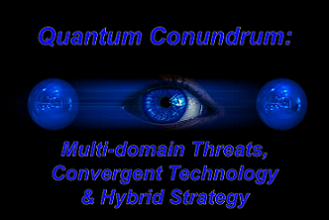


I enjoyed the article. I think some considerations are needed for implementation of this type of technology. First, we need to understand the technology at a deeply scientific-level. This includes especially our Officers, WOs, and NCOs. Our Army, or DoD writ large, is very complacent in the way we think about our situation when it comes to “War” and “Warfare” mainly due to the overvalued compensation of our vast “Historic Knowledge”. Most, not all, of our great ideas are merely ideas and have no real application in “War”. Second, we need to consider upgrading our workforce as well as restructuring how we view “War” both militarily and academically. In all the years I have served, everyone usually defaults to the loud obnoxious Combat Arms officer with a History background. This needs to end if we were to incorporate any real change that is revolutionary to military affairs. History has its place and creating true change is not one of them. Finally, we ought to adjust our internal professional education areas of focus. In attending Command and General Staff College as a young Major, I realized that the academic work was built upon a bias that the curriculum developers thought would help advance individual careers by supporting one person make a decision, namely a commander. This is very “Cold War-ian” and not representative of the instrumental changes in how we view “War” today and the generations who were raised within a different reality of information sharing. Simply, we need real change in our Army and DoD, writ large in order to embrace the full potential of quantum technologies – and we unfortunately do not have that within our country.